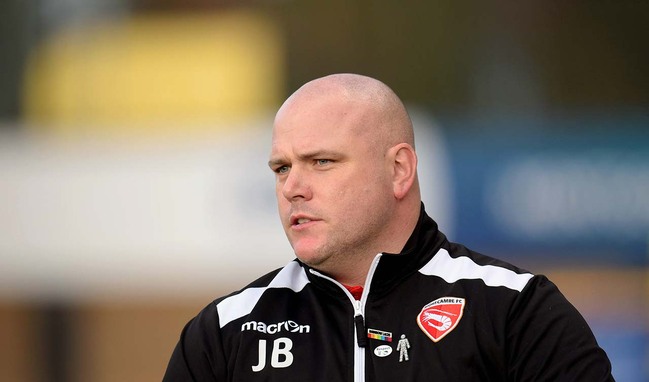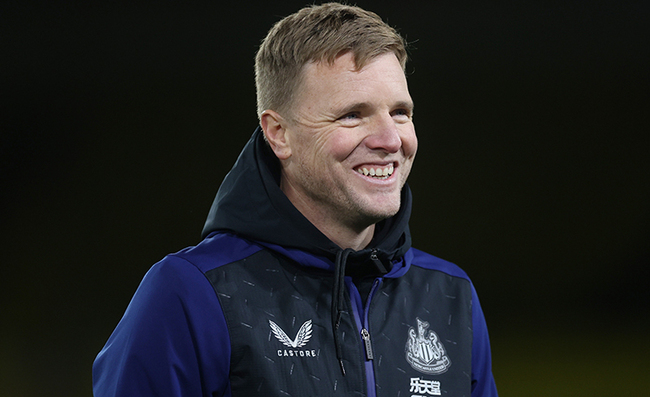




OUR BEST EVER OFFER - SAVE £100/$100
JOIN THE WORLD'S LEADING PROFESSIONAL DEVELOPMENT PROGRAMME
- 12 months membership of Elite Soccer
- Print copy of Elite Player & Coach Development
- Print copy of The Training Ground
You are viewing 1 of your 1 free articles
Using the goalkeeper in build-up play
This session is designed to incorporate the goalkeeper in the build-up phase of possession, moving from an unopposed passing drill to opposed end-zone games, and finishing with an 11v11.
| Area | Full pitch |
| Equipment |
Poles, cones, flat discs, mini goals |
| No. of Players | 20 + 4 goalkeepers |
| Session Time |
75mins (including warm-up prior to activities) Passing drill: 2x3mins Mini goal game: 3x3mins Six mini goal game: 2x6mins 11v11: 2x10mins |
This session is designed to incorporate the goalkeeper in the build-up phase of possession, moving from an unopposed passing drill to opposed end-zone games, and finishing with an 11v11.
Many teams are now deploying a very aggressive, player-orientated high pressing system against the ball. Using the goalkeeper in our build-up phase gives us a numerical advantage, enabling us to always have a free player when getting pressed. Working on an understanding of where the pressure is coming from and how to find the free player gives us a greater chance of playing through the press and gaining more control in the game.
We run this session regularly during pre-season. Playing through an aggressive press obviously comes with an element of risk, so it is important to get the right actions before the season starts. In season,
we revisit this weekly in possession-based sessions.
WARM-UP PASSING DRILL
Set up three spaces with poles, each 10x15m. Divide the players into three groups of eight. In their groups, players play one or two touch, moving vertically up and down, working on passing combinations (bouncing centrally to wide areas, lay-ups, etc) [1]. You can vary this by moving players inside and outside the space from time to time, with only the top players staying on top. Here we are working on the technique of the pass, body shape, and receiving skills.
[1]
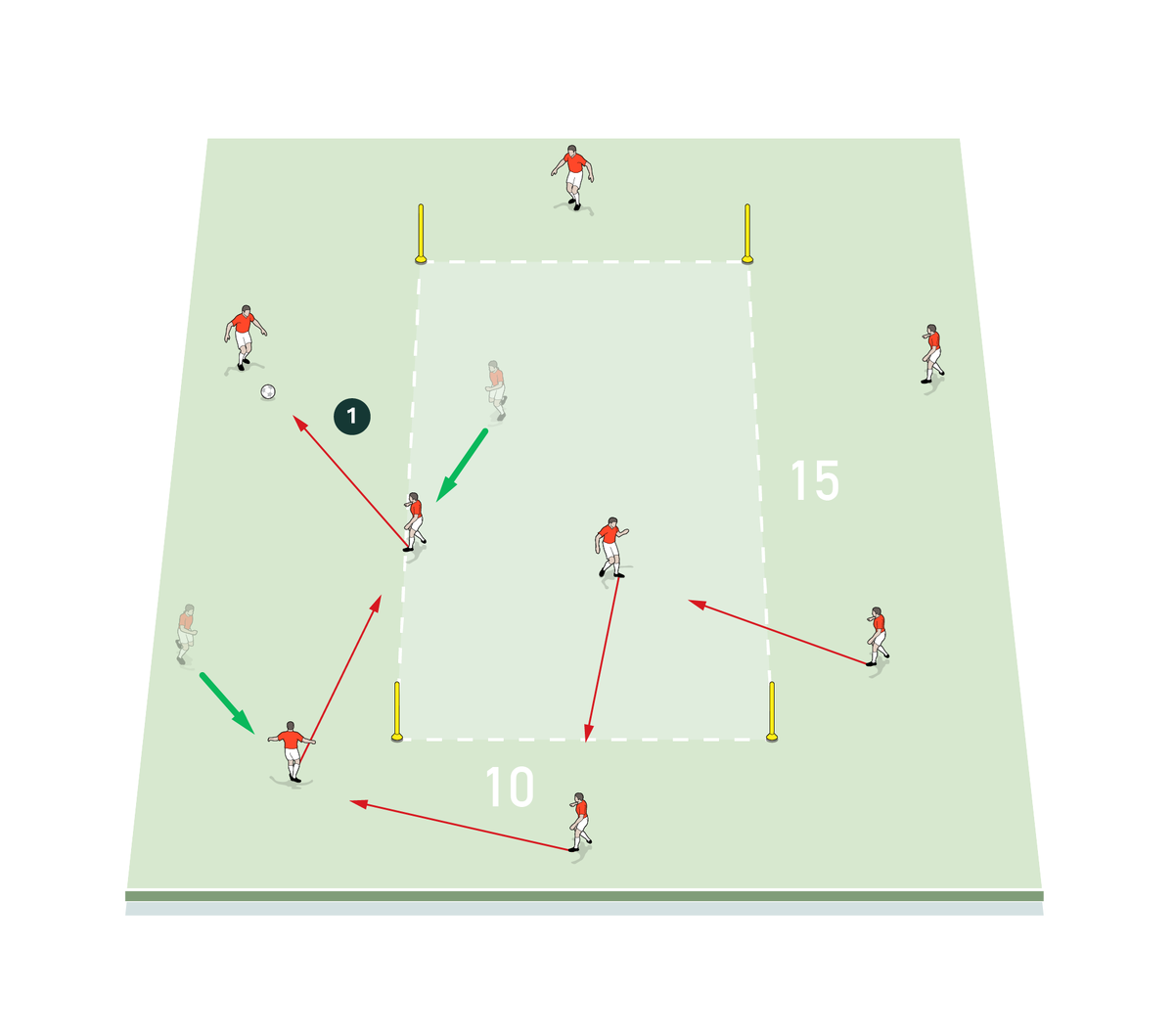
-
Players use one or two touches, moving ball up and down, working on combinations
MINI GOAL GAME
Set up two pitches with poles and cones, each 15x25m. Split the squad into two groups, and within those groups set up for 5v5 plus two goalkeepers. The rules of the game are that the team in possession can only score in the end-zone into mini goals. They can play with their goalkeeper when in possession [2]. Goalkeepers can’t be pressed by outfield players, and the defending goalkeeper doesn’t defend the goal. Here we are working on decision-making, selection and timing of passes.
[2]

-
Play starts with goalkeeper in possession
-
Red team pass ball and create combinations
-
When in end-zone, red team score in mini goal
-
Defending goalkeeper does not defend attack
SIX MINI GOAL GAME
This time, set up a pitch with poles from box to box, with end-zones of 15m in front of the mini goals. We go into an 11v11 end-zone game, with rules the same as the previous activity, but now the outfield players can press the goalkeeper in possession, and the defending goalkeeper can defend the three mini goals [3]. The game always restarts with the goalkeepers. Here we are working on the goalkeeper dealing with pressure, and finding the right solutions.
[3]
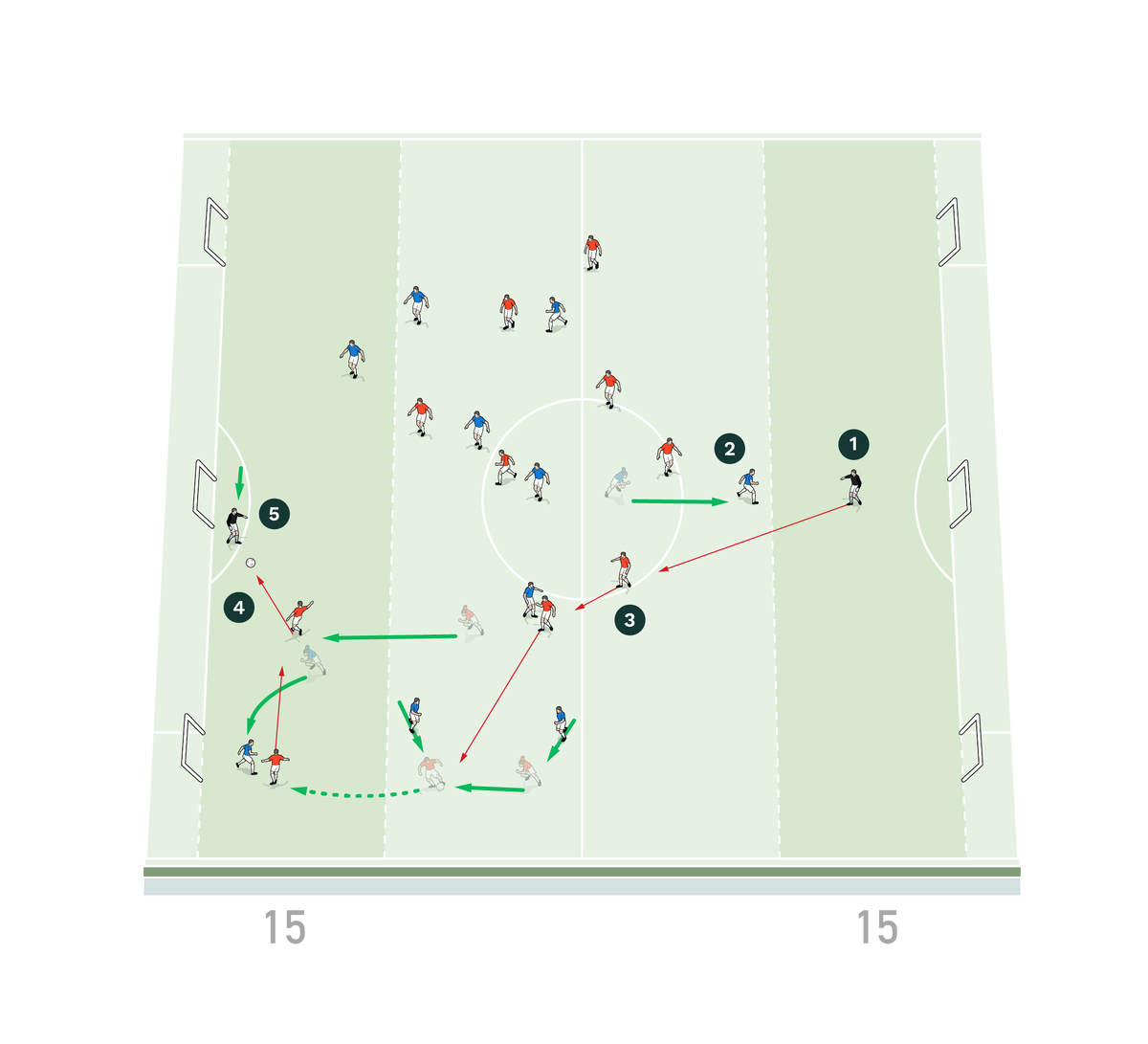
-
Play starts with goalkeeper
-
Blue team can now press red goalkeeper
-
Red team look to pass and create combinations
-
Red team look to score in mini goal
-
Blue goalkeeper can defend mini goal
11v11 FULL PITCH GAME
We end by progressing the previous activity, using all the same rules, but this time we play on a full pitch with full size goals [4]. We are looking to apply in a match situation all the skills we’ve explored.
[4]
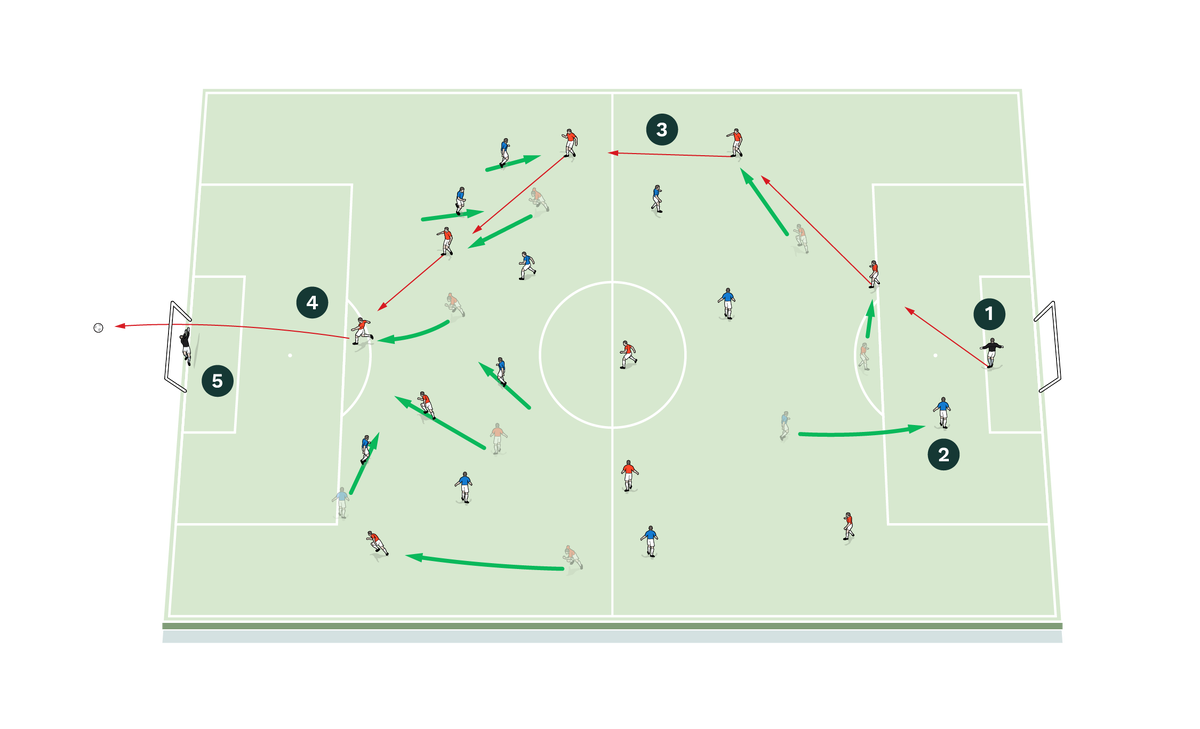
-
Play starts with goalkeeper
-
Blue team press red goalkeeper
-
Red team look to pass and create combinations
-
Red team look to score in goal
-
Blue goalkeeper can defend goal
COACHING POINTS
What are the key things to look out for technically and tactically?
Technically: the positioning of the goalkeeper and the outfield players (availability, height, width, and the creation of short passing distances); the first touch and open stance of the goalkeeper; an open stance for outfield players to receive the ball; finding the spare player when the opponent attacks the goalkeeper; using the bounce for a better passing angle.
Tactically: getting the defending teams to challenge differently by sometimes attacking the goalkeeper and sometimes waiting; attacking the goalkeeper from the centre or from the outside.
What are the typical mistakes that players might make, and how do you avoid them?
The goalkeeper may not wait for the pressure; they need to be composed and not play early passes without pressure from the opponent. The goalkeeper needs to always have the ball in control to play quickly when the pressure comes. The goalkeeper may also play to the wrong side when the opponent presses, so a focus on the spare player is needed, and an understanding of where the pressure comes from.
Outfield players may also not understand where the pressure is coming from, and need to be encouraged to think about a bounce pass – ie straight pressure = diagonal bounce, diagonal pressure = vertical bounce.
Related Files
Editor's Picks
Attacking transitions
Deep runs in the final third
Using the goalkeeper in build-up play
Intensive boxes drill with goals
Penetrating the final third
Creating and finishing
My philosophy
Pressing initiation
Compact team movement
Coaches' Testimonials

Alan Pardew

Arsène Wenger

Brendan Rodgers

Carlos Carvalhal

José Mourinho

Jürgen Klopp

Pep Guardiola

Roy Hodgson

Sir Alex Ferguson

Steven Gerrard
Coaches' Testimonials

Gerald Kearney, Downtown Las Vegas Soccer Club

Paul Butler, Florida, USA

Rick Shields, Springboro, USA

Tony Green, Pierrefonds Titans, Quebec, Canada
Join the world's leading coaches and managers and discover for yourself one of the best kept secrets in coaching. No other training tool on the planet is written or read by the calibre of names you’ll find in Elite Soccer.
In a recent survey 92% of subscribers said Elite Soccer makes them more confident, 89% said it makes them a more effective coach and 91% said it makes them more inspired.
Get Monthly Inspiration
All the latest techniques and approaches
Since 2010 Elite Soccer has given subscribers exclusive insight into the training ground practices of the world’s best coaches. Published in partnership with the League Managers Association we have unparalleled access to the leading lights in the English leagues, as well as a host of international managers.
Elite Soccer exclusively features sessions written by the coaches themselves. There are no observed sessions and no sessions “in the style of”, just first-hand advice delivered direct to you from the coach.





